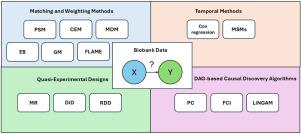利用生物银行数据推进医学因果推理。
IF 4.5
2区 医学
Q2 COMPUTER SCIENCE, INTERDISCIPLINARY APPLICATIONS
引用次数: 0
摘要
从观察病历数据中进行因果推断对于提高医疗保健的准确性和个性化至关重要。最近,生物银行——与遗传、生活方式、环境和健康相关数据相关的生物样本的收集——已成为大规模人口研究的宝贵资源。通过整合这些资源,生物银行为每个人提供了一个统一的不同数据存储库,捕捉现实世界的医疗事件,包括程序、治疗和诊断。然而,这些资源经常受到混杂因素、选择偏差和信息缺失的影响,对得出有效的因果结论构成了重大挑战。虽然随机对照试验(rct)仍然是药物开发和医疗决策的黄金标准,但越来越多的观察数据的可用性突出了对可靠的因果推理方法的需求。本研究概述了从适用于生物库数据的观察数据推断治疗对结果的影响的方法,重点介绍了它们解决的独特挑战。我们的目标是介绍目前在观察性医学数据中用于因果发现的方法。我们将讨论经典和现代的方法,这些方法提供了重要的机会,同时也难以达到因果关系。我们涵盖了为大型生物银行设计的统计方法,这些方法有可能改善临床决策,指导公共卫生政策,并推动进一步的研究。本文章由计算机程序翻译,如有差异,请以英文原文为准。

Advancing causal inference in medicine using biobank data
Causal inference from observational medical record data is critical for advancing precision and personalization in healthcare. Recently, biobanks – collections of biological samples linked with genetic, lifestyle, environmental, and health-related data – have emerged as valuable resources for large-scale population studies. By integrating these resources, biobanks offer a harmonized repository of diverse data for each individual, capturing real-world medical events, including procedures, treatments, and diagnoses. However, these resources are often affected by confounding factors, selection biases, and missing information, posing significant challenges to drawing valid causal conclusions. While randomized controlled trials (RCTs) remain the gold standard for drug development and medical decision-making, the growing availability of observational data highlights the need for robust causal inference methodologies. This study provides an overview of methods for inferring the effect of a treatment on an outcome from observational data applicable to biobank data, focusing on the unique challenges they address. Our objective is to introduce current methods used for causal discovery in observational medical data. We discuss classic and modern methodologies that offer significant opportunities alongside the difficulty in reaching causality. We cover statistical methods designed for large-scale biobanks that have the potential to improve clinical decision-making, guide public health policies, and drive further research.
求助全文
通过发布文献求助,成功后即可免费获取论文全文。
去求助
来源期刊

Journal of Biomedical Informatics
医学-计算机:跨学科应用
CiteScore
8.90
自引率
6.70%
发文量
243
审稿时长
32 days
期刊介绍:
The Journal of Biomedical Informatics reflects a commitment to high-quality original research papers, reviews, and commentaries in the area of biomedical informatics methodology. Although we publish articles motivated by applications in the biomedical sciences (for example, clinical medicine, health care, population health, and translational bioinformatics), the journal emphasizes reports of new methodologies and techniques that have general applicability and that form the basis for the evolving science of biomedical informatics. Articles on medical devices; evaluations of implemented systems (including clinical trials of information technologies); or papers that provide insight into a biological process, a specific disease, or treatment options would generally be more suitable for publication in other venues. Papers on applications of signal processing and image analysis are often more suitable for biomedical engineering journals or other informatics journals, although we do publish papers that emphasize the information management and knowledge representation/modeling issues that arise in the storage and use of biological signals and images. System descriptions are welcome if they illustrate and substantiate the underlying methodology that is the principal focus of the report and an effort is made to address the generalizability and/or range of application of that methodology. Note also that, given the international nature of JBI, papers that deal with specific languages other than English, or with country-specific health systems or approaches, are acceptable for JBI only if they offer generalizable lessons that are relevant to the broad JBI readership, regardless of their country, language, culture, or health system.
 求助内容:
求助内容: 应助结果提醒方式:
应助结果提醒方式:


